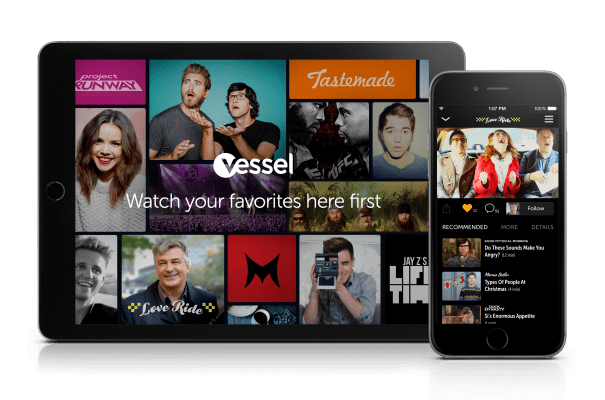Former Hulu CEO Jason Kilar is finally ready to take the wraps off what he’s been working on for the past 18 months… and, well, it looks a lot like Hulu. But while that service was built to usher TV into the digital world, Kilar and his team are focused on creating a product around creators who already have videos and an audience online.
The company Kilar founded along with his former CTO Rich Tom is called Vessel, and you might think of it as a sort of Hulu for the YouTube generation. The company hopes to create a new subscription video service, priced at $2.99 a month, that will provide early access to videos consumers would normally watch for free on YouTube.
Like Hulu, Vessel will aggregate a variety of video content all in one place. Like Hulu, Vessel will have a website and apps through which viewers will be able to find that content. And like Hulu, Vessel will provide a mix of subscription video available and free, ad-supported content.
But while Hulu was heavily dependent on what you’d think of as traditional media companies for most its content, Vessel is reaching out to creators who have been making content specifically for the web, hoping to bring them all together under one roof.
Promising Better Monetization For Creators
The pitch to creators is that they will be able to make a whole lot more money by sharing their videos through Vessel then by releasing them strictly through the free, ad-supported web.
Kilar estimates most creators make an average of about $2.20 per thousand impressions for their videos on sites like YouTube. But with Vessel, he says they’ll be able to make upwards of $50 CPMs for the same content. That could be an attractive proposition for a number of creators who have railed against low monetization on YouTube and the huge cut that the site takes out of their earnings.
Vessel hopes to increase monetization by introducing a few old concepts to a new group of video creators and consumers. First, it wants to create what you’d think of as a bundle of channels made up of digital-first video creators. Second, it hopes to bring windowing into that digital-first video world.

Vessel co-founders Jason Kilar and Richard Tom
Just as people subscribe to cable for a bundle of channels and shows, Vessel thinks they’ll be willing to pay for access to a curated group of online video channels. And just as movie goers pay more for a film in theatres than renting online or on DVD, the company believes a new group of consumers will shell out for early access to videos that they would otherwise be able to see for free in a later window.
Vessel doesn’t expect creators to make their videos available only through its website or apps — it’s just asking to distribute their content first. The company hopes to get creators to agree to a 72-hour “early access” window for their content, which consumers will only be able to see if they are Vessel subscribers.
After that, creators are free to do whatever they wish with their videos. They can put their content up on YouTube or their own sites or whatever other distribution channels they usually rely on.
While subscription is one piece of Vessel’s monetization strategy, it’s not the only one. Just as Hulu Plus subscribers still had to watch ads when viewing shows in its first-look window, Vessel users will also see ads against the videos they watch — whether or not they’re a subscriber.
Recognizing that digital-first content is generally short-form in nature, Vessel plans to run less obtrusive, 5-second pre-rolls before videos than the 15- or even 30-second ads that are commonplace on other sites and apps. It will also have full-bleed interactive ads that will occasionally appear while users are browsing content.
Vessel already has some creators signed up, but it’s looking for more. As a result, it’s launched an early creator preview as a sort of showcase for what the app will look like and how their content will appear.
Creator pages feature what Vessel calls full-bleed “motion posters” to highlight their content, and the service makes it easy for users to subscribe to individual channels or to different categories of content. Users can also choose to “like” or comment on pieces of content, even as they watch videos in-line.
But Will Consumers Buy It?
While it’s easy to see why creators would be excited, for consumers the value proposition is a little trickier. After all, the company is asking them to pay $2.99 for access to content they could just wait three days to watch on YouTube. That said, even if they don’t subscribe, Vessel still thinks that it can better monetize their views thanks to a better user interface and more appealing ads.
Before you write Vessel off and argue that its business model isn’t viable, however, it’s worth looking back at what Jason Kilar and team built at Hulu. After all, there were plenty of Hulu naysayers prior to its launch. They called it ClownCo. They said it wouldn’t work. Many argued that consumers wouldn’t pay for next-day access to video content online that they could get through broadcast TV for free.
But at the end of the day, the Hulu model ended up working pretty well. By the time Kilar and Tom announced they were leaving in early 2013, Hulu had grown its revenue base to nearly $700 million a year, which included 3 million paying Hulu Plus customers.
The service only continued to grow after they left, reporting more than $1 billion in revenue by year-end last year, which is the last time the company released numbers.
So don’t count Kilar and team out. They convinced consumers to pay for content which had been available for free online once before. Maybe they can do it again.
